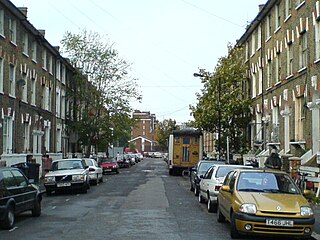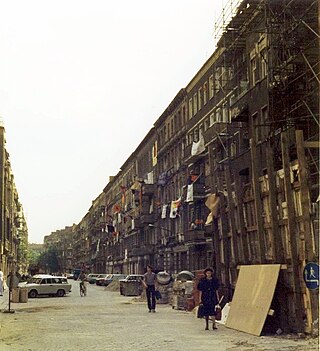Related Research Articles

Squatting is the action of occupying an abandoned or unoccupied area of land or a building, usually residential, that the squatter does not own, rent or otherwise have lawful permission to use. The United Nations estimated in 2003 that there were one billion slum residents and squatters globally. Squatting occurs worldwide and tends to occur when people find empty buildings or land to occupy for housing. It has a long history, broken down by country below.

Villa Amalia is the name of the building that hosted the former Second High School of Athens in Greece. It is located on the corner of Acharnon and Heiden streets, near Victoria metro station. It was an anarchist squat before its eviction in 2012. It reopened as a school in 2016.

St Agnes Place was a squatted street in Kennington, south London, which resisted eviction orders for more than 30 years. When a number of derelict houses were scheduled for demolition to extend Kennington Park in 1969, squatters occupied the properties and a High Court injunction prevented the demolition. The street was run by a housing cooperative until 2005, when Lambeth London Borough Council obtained an eviction order. Demolition was completed in 2007.
Jack Tafari was a sometimes homeless Rastafari activist who advocated for himself and other homeless people, in the US and the UK. He was best known for promoting "sanctioned tent cities" as transitional housing for homeless people, including himself, in Portland, Oregon, United States.
The Battle of Ryesgade was a nine-day series of street fights in mid-September 1986, in the Copenhagen street Ryesgade. It was the most violent event in a long-standing conflict between the Copenhagen City Council and the city's community of squatters. Faced with an ultimatum to leave their illegally occupied housing or face eviction, the squatters instead fortified the streets around their building so strongly that it became a cop-free zone. They took advantage of this lack of control by burning down a building belonging to the Sperry Corporation. For nine days, massed police unsuccessfully attempted to evict the squatters. The civil disorder was of a magnitude never before seen in Denmark. After communicating a manifesto through the media, the defenders finally abandoned the squat and dispersed without being apprehended.
The Advisory Service for Squatters (A.S.S.) is a non-profit group based in London and run by volunteers. It aims to provide practical advice and legal support for squatters. It was founded in 1975, having grown out of the Family Squatters Advisory Service. After being based for many years in St. Paul's Road in Islington, A.S.S. moved its offices to Whitechapel High Street, in the same building as Freedom Press.
Dos Blockos was a squat situated at 713 East 9th Street in Alphabet City, Manhattan, New York City. In active use as a squat from 1992 onwards, the six-story building housed up to 60 people at its peak, including Brad Will. The building funded repairs by being a set for movies. The squatters were evicted in 1999 and the building was converted into a commercial apartment building.
The Frances Street Squats were a set of six squatted houses, including one women-only building, that existed between February and November 1990 in Vancouver, Canada. They were occupied by SAVE and took a stand against development which was generally supported by local people. The Vancouver Police Department evicted the buildings.
The Windsor Free Festival was a British free festival held in Windsor Great Park from 1972 to 1974. Organised by some London commune dwellers, notably Ubi Dwyer and Sid Rawle, it was in many ways the forerunner of the Stonehenge Free Festival, particularly in the brutality of its final suppression by the police, which led to a public outcry about the tactics involved.

Bill 'Ubi' Dwyer or William Ubique Dwyer was an anarchist activist in New Zealand, Australia, England and his native Ireland and is best known as the originator and principal organiser of the Windsor Free Festival.

Sidney William Rawle was a British campaigner for peace and land rights, free festival organiser, and a former leader of the London squatters movement. Rawle was known to British tabloid journalists as 'The King of the Hippies', not a title he ever claimed for himself, but one that he did eventually co-opt for his unpublished autobiography.

In England and Wales, squatting— taking possession of land or an empty house the squatter does not own—is a criminal or civil offense, depending on circumstances. People squat for a variety of reasons which include needing a home, protest, poverty, and recreation. Many squats are residential; some are also opened as social centres. Land may be occupied by New Age travellers or treesitters.

The 2016 Bendigo Street housing dispute concerned a series of occupations of houses in Collingwood, Melbourne, Australia. The properties were owned by the Victorian Government which had made aborted plans to construct the East West Link road. The houses, mostly on Bendigo Street, became the centre of a lengthy dispute between the government, Victoria Police and the Homeless Persons Union.

The Vondelstraat riots were violent disturbances on Vondelstraat in Amsterdam, the Netherlands between squatters and the state in March 1980. It also involved the deployment of military tanks on the streets for the first time since World War II, and was one of the most serious disturbances involving squatters in the country.
Squatters' Action for Secure Homes (SQUASH) is an activist group formed first in the 1990s in the United Kingdom to represent the interests of squatters and to fight the proposed criminalisation of squatting. It then reformed in 2011, when there were again parliamentary discussions about making squatting illegal. After squatting was (partially) criminalised in 2012, the group continues to monitor arrests and convictions.

Squatting in the Republic of Ireland is the occupation of unused land or derelict buildings without the permission of the owner. In the 1960s, the Dublin Housing Action Committee highlighted the housing crisis by squatting buildings. From the 1990s onwards there have been occasional political squats in Cork and Dublin such as Grangegorman, the Barricade Inn, the Bolt Hostel, Connolly Barracks, That Social Centre and James Connolly House.

The battle of Mainzer Straße took place in Friedrichshain, East Berlin between 12 and 14 November 1990. It was a major incident in the history of the city, following the fall of the Berlin Wall in 1989. The magistrate of East Berlin decided to evict a row of squatted apartment blocks and the autonomous movement resisted the eviction for three days, until the buildings were all evicted by the police. One person was wounded by a ricochet and 417 people were arrested in an operation of over 3,000 officers. Following the riots, the magistrate decided to concentrate on legalizing squats in Berlin.

Squatting in Chile is the occupation of unused land or derelict buildings without the permission of the owner. From the 1960s onwards, informal settlements known as callampas were permitted although there were also evictions such as the massacre of Puerto Montt in 1969. In the 1970s, the government of Salvador Allende encouraged occupations, then following the coup d'état, the military junta repressed squatting. Callampas then became known as campamentos.

Urban areas in the Philippines such as Metro Manila, Metro Cebu, and Metro Davao have large informal settlements. The Philippine Statistics Authority defines a squatter, or alternatively "informal dwellers", as "One who settles on the land of another without title or right or without the owner's consent whether in urban or rural areas". Squatting is criminalized by the Urban Development and Housing Act of 1992, also known as the Lina Law. There have been various attempts to regularize squatter settlements, such as the Zonal Improvement Program and the Community Mortgage Program. In 2018, the Philippine Statistics Authority estimated that out of the country's population of about 106 million, 4.5 million were homeless.
The modern political squatting movement began in Hamburg, Germany, when Neue Große Bergstraße 226 was occupied in 1970. Squatters wanted to provide housing for themselves amongst other demands such as preventing buildings from being demolished and finding space for cultural activities. The Hafenstraße buildings were first occupied in 1981 and were finally legalized after a long political struggle in 1995. The still extant Rote Flora self-managed social centre was occupied in 1989. Squatting actions continue into the present; more recent attempts are quickly evicted, although the Gängeviertel buildings were squatted and legalized in the 2010s.
References
- 1 2 3 4 5 6 7 Platt, Steve (1980). "A Decade of Squatting". In Wates, Nick; Wolmar, Christian (eds.). Squatting the Real Story. London: Bay Leaf Books. ISBN 0950725919.
- 1 2 3 Issimdar, Mariam (5 October 2019). "When hippy squatters took over a Piccadilly mansion". BBC News . Retrieved 25 March 2024.
- ↑ "1969: Police storm squat in Piccadilly". BBC ON THIS DAY. 21 September 1969. Retrieved 16 September 2014.
- 1 2 Adeney, Martin; Ezard, John (21 September 2010). "From the archive: 22 September 1969, 'Hippies' roam London after police raid". the Guardian. Retrieved 16 September 2014.
- ↑ "Professor Phil Cohen". Institute of Advanced Studies (IAS). 25 May 2018. Retrieved 5 April 2019.
- 1 2 3 4 5 6 7 8 Baker, Rob (8 June 2018). "The forgotten story of the 'Dilly Dossers' and London's most luxurious hippy squat". Daily Telegraph. Retrieved 5 April 2019.
- 1 2 3 4 5 6 7 8 9 "Hippies in Piccadilly – The Events of September 1969". The British Newspaper Archive Blog. 15 April 2020. Retrieved 25 March 2024.
- ↑ May, John (15 September 2010). "Sid Rawle obituary". The Guardian . Retrieved 25 March 2024.
- ↑ Baker, Rob (2015). Beautiful Idiots and Brilliant Lunatics: A Sideways Look at Twentieth-Century London. Amberley. ISBN 978-1445651194.
- ↑ "22 September 1969, 'Hippies' roam London after police raid". The Guardian . 22 September 1969. Retrieved 25 March 2024.
- ↑ Baker, Rob (4 January 2019). "Extraordinary Pictures of 'Hippiedilly' on Hyde Park Corner in 1969" . Retrieved 25 March 2024.
